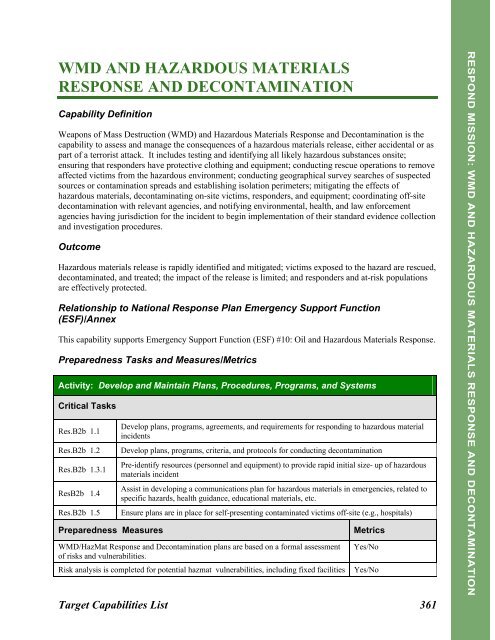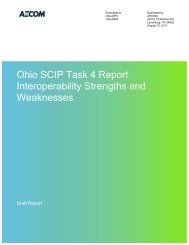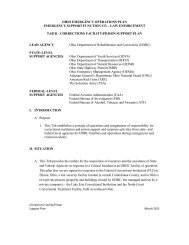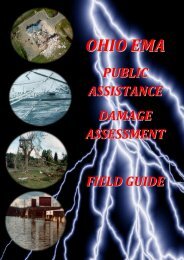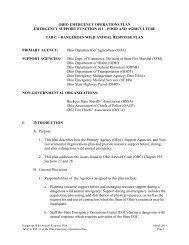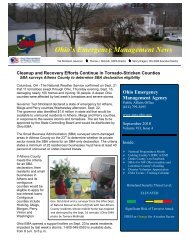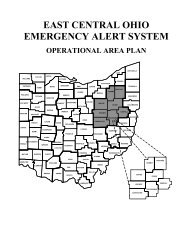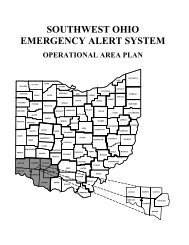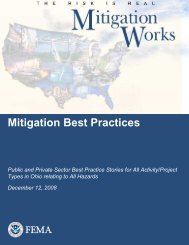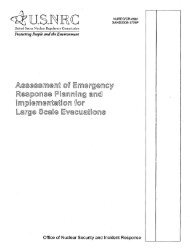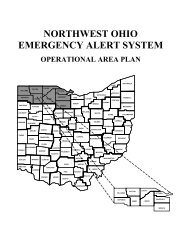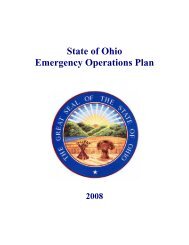wmd and hazardous materials response and decontamination
wmd and hazardous materials response and decontamination
wmd and hazardous materials response and decontamination
You also want an ePaper? Increase the reach of your titles
YUMPU automatically turns print PDFs into web optimized ePapers that Google loves.
RESPOND MISSION: WMD AND HAZARDOUS MATERIALS RESPONSE AND DECONTAMINATIONRes.B2b 3.2.8Res.B2b 3.4.7.6Res.B2b 3.2.6.3Res.B2b 3.4.7.7Performance MeasuresCoordinate resource management of hazmat equipment, supplies, <strong>and</strong> personnelRequest <strong>decontamination</strong> technical assistance resourcesCoordinate with safety officer to brief hazmat branch/group personnel on-site-specificoccupational safety <strong>and</strong> health issues involving hazmat/WMD releasesIssue instructions for self-<strong>decontamination</strong>, where appropriate, expedient <strong>and</strong> possibleNumber of loss-time injuries (per deployment) of WMD/hazmatResponse <strong>and</strong> Decontamination personnel during rescue effortsTime in which tactical plan is developed, based on the incident actionplan (IAP), <strong>and</strong> for implementation by the State, region, <strong>and</strong>/or localWMD/hazmat Response <strong>and</strong> DecontaminationMetric364 Target Capabilities List
Activity: Identify the HazardDefinition: Upon arriving on scene, begin to assess site, sample, identify, <strong>and</strong> characterizeWMD/hazmat <strong>and</strong> contamination situation, conduct hazard analysis to determine potentialconsequence <strong>and</strong> risk, develop plans for safety <strong>and</strong> hazmat/<strong>decontamination</strong> operations, <strong>and</strong> setup hazmat zones.Critical TasksRes.B2b 5.1.1Res.B2b 5.1Res.B2b 5.2Res.B2b 5.2.1Res.B2b 5.5.3Res.B2b 5.2.2Res.B2b 5.2.3Res.B2b 5.2.3.1Res.B2b 5.5.2Res.B2b 5.5Res.B2b 5.3Res.B2b 5.4Performance MeasuresNotify law enforcement for guidance on collection <strong>and</strong> management of evidence from potentialcrime scenesInitiate hazmat <strong>response</strong>Survey the incident sceneIdentify hazmat <strong>and</strong> the extent/scope of the incidentAnalyze weather forecast to conduct hazard zone predictionConduct contamination surveysAssess hazmat release situationConduct oil <strong>and</strong> hazmat assessmentMonitor movement of <strong>hazardous</strong> releases <strong>and</strong> formulate predictions on dispersion <strong>and</strong>characteristics over timeCharacterize consequences <strong>and</strong> riskIdentify <strong>and</strong> establish perimeter <strong>and</strong> hazmat zones (hot, warm, cold)Conduct ongoing assessments <strong>and</strong> predictionsTime in which area is isolated <strong>and</strong> public access is controlledTime in which <strong>hazardous</strong> <strong>materials</strong> or category involved areidentifiedActivity: Assess Hazard <strong>and</strong> Evaluate RiskMetricWithin 15 minutes from arrival on sceneWithin 30 minutes from arrival on sceneDefinition: Assess the hazards present, evaluate the level of risk to both responders <strong>and</strong> thepublic, <strong>and</strong> develop <strong>and</strong> Incident Action Plan (IAP) to address the <strong>response</strong> problemCritical TasksRes.B2b 5.5.1Res.B2b 5.5.1.1Res.B2b 5.5.1.2Res.B2b 5.5.1.3Res.B2b 5.5.2Collect, prioritize, <strong>and</strong> manage data <strong>and</strong> information from all sourcesDevelop incident monitoring <strong>and</strong> sampling strategy based upon a realistic assessment ofoperational hazardsConduct sampling operationsIdentify, classify, <strong>and</strong> verify suspected non-biological WMD/hazmat samples through the use ofat least two (preferably three) different instrument technologiesUse plume dispersion models <strong>and</strong> other analytical tools to generate ongoing WMD/hazmatdispersion assessmentsTarget Capabilities List 365RESPOND MISSION: WMD AND HAZARDOUS MATERIALS RESPONSE AND DECONTAMINATION
RESPOND MISSION: WMD AND HAZARDOUS MATERIALS RESPONSE AND DECONTAMINATIONRes.B2b 5.5Res.B2b 3.2.5.1Res.B2b 5.3Res.B2b 5.3.1Res.B2b 5.3.2Res.B2b 5.3.3Res.B2b 5.4Performance MeasuresImplement risk evaluation process that adequately addresses the risk of various actions to bothresponders <strong>and</strong> the publicDevelop <strong>and</strong> implement an Incident Action Plan (IAP) specific to WMD/hazmat issues basedupon the risk evaluation processEstablish <strong>and</strong> identify visually an isolation perimeter (outer perimeter) to isolate the area <strong>and</strong>deny entryEstablish a hot zone (inner perimeter) to identify high hazard area(s) where responders willoperateEstablish other hazard control zones, based upon scope <strong>and</strong> nature of the eventMake offensive or defensive reconnaissance operations, as necessary, to gather intelligence onthe situationConduct ongoing assessments <strong>and</strong> predictionsTime in which preliminary estimate of number of victims exposedto toxic/<strong>hazardous</strong> material <strong>and</strong> source identification is obtainedTime in which the at-risk population is identified <strong>and</strong> protectiveaction recommendations are madeTime in which the WMD/hazmat elements of the overall IAP aredevelopedActivity: Conduct Rescue OperationsMetricWithin 2 hours from arrival on sceneWithin 1 hour from arrival on sceneWithin 1 hour from arrival on sceneDefinition: Once on-scene <strong>and</strong> equipped with protective <strong>and</strong> <strong>response</strong> equipment, implementrescue operations.Critical TasksRes.B2b 6.1Res.B2b 6.1.1Res.B2b 6.2Res.B2b 6.2.1Res.B2b 6.2.2Res.B2b 6.3Res.B2b 6.3.1Res.B2b 6.3.2Res.B2b 6.3.3Performance MeasuresDetermine the nature <strong>and</strong> priority of rescue operations <strong>and</strong> the numbers involvedIdentify personnel <strong>and</strong> equipment requirements to initiate rescue operationsImplement safe <strong>and</strong> effective tactics to accomplish rescue operation objectivesExtricate <strong>and</strong> rescue victims within the hot zoneCoordinate rescue efforts with law enforcement to ensure safety of rescuersImplement secondary public protective actions (PPAs)Identify personnel <strong>and</strong> equipment requirements to initiate product/agent control operationsImplement safe <strong>and</strong> effective tactics to accomplish product/agent control objectivesImplement safe <strong>and</strong> effective tactics to support product/agent control objectivesTime in which contaminated victims are rescued fromcontaminated areaMetricWithin 2 hours from arrival on scene366 Target Capabilities List
Activity: Conduct Mitigation ActivitiesDefinition: Once on scene <strong>and</strong> equipped with protective <strong>and</strong> <strong>response</strong> equipment, implementoperations plan to minimize contamination.Critical TasksRes.B2b 7.1.3Res.B2b 7.1.1Res.B2b 7.1.2Res.B2b 7.1Res.B2b 7.2Performance MeasuresIdentify appropriate PPE based on suspected <strong>hazardous</strong> materialCoordinate with safety officer to monitor responders for exposure to hazmatCoordinate with safety officer to monitor <strong>and</strong> control the operating time of rescuers assigned tothe hot zone to minimize rescuer exposureSecure the contamination source <strong>and</strong> affected areasMonitor <strong>and</strong> track compliance with containment requirementsTime in which implementation of initial action plan <strong>and</strong>objectives is initiatedTime in which hazmat/WMD contamination is containedMetricWithin 4 hours from arrival on sceneWithin 12 hours from arrival on sceneActivity: Conduct Decontamination <strong>and</strong> Clean-up /Recovery OperationsDefinition: Upon arrival on scene <strong>and</strong> with the requisite equipment, initiate <strong>response</strong> operationsto reduce the level of on-scene contamination, minimize the potential for secondarycontamination beyond the incident scene, <strong>and</strong> ensure an effective transition to clean-up <strong>and</strong>recovery operations.Critical TasksRes.B2b 8.1Res.B2b 8.2Res.B2b 8.4.5Res.B2b 8.4.6Res.B2b 8.3.1Res.B2b 8.4.1Res.B2b 8.4Res.B2b 8.4.2Res.B2b 8.4.7Res.B2b 8.4.7.1Res.B2b 8.4.8Res.B2b 8.4.9Identify assets required for <strong>decontamination</strong> activitiesIdentify the type of contaminants, nature of <strong>response</strong> operations, <strong>and</strong> the required type/level of<strong>decontamination</strong> operationsImplement plans, procedures, <strong>and</strong> protocols to ensure on-site individual gross <strong>decontamination</strong>of persons <strong>and</strong> household pets affected by the incidentProvide a means to allow medical treatment facilities <strong>and</strong> shelter managers to readily identifypeople who have received gross <strong>decontamination</strong>Establish <strong>decontamination</strong> sites for victimsScreen affected personsImplement emergency <strong>decontamination</strong> operationsDecontaminate victims exposed to chemical, biological, radiological, nuclear, or explosive(CBRNE) <strong>materials</strong>Implement technical <strong>decontamination</strong> operations for injured, contaminated victimsImplement technical <strong>decontamination</strong> of human remainsImplement technical <strong>decontamination</strong> operations in support of WMD/hazmat entry <strong>and</strong><strong>response</strong> activitiesImplement <strong>decontamination</strong> operations to address incident-specific scenarios <strong>and</strong> requirementsTarget Capabilities List 367RESPOND MISSION: WMD AND HAZARDOUS MATERIALS RESPONSE AND DECONTAMINATION
RESPOND MISSION: WMD AND HAZARDOUS MATERIALS RESPONSE AND DECONTAMINATIONRes.B2b 8.4.9.1Res.B2b 8.5.1Res.B2b 9.2.3Res.B2b 9.2.2Res.B2b 9.2.4Res.B2b 9.2Res.B2b 9.4.1Res.B2b 9.4.2Performance MeasuresDecontaminate pets, if resources are availableCoordinate livestock <strong>decontamination</strong>Monitor clean areas within the contamination control lineMonitor the exit points for hazmat contaminate movement outside the isolation zoneCoordinate with environmental authorities to ensure the appropriate <strong>decontamination</strong> areaclean-up <strong>and</strong> disposal of waste <strong>materials</strong>Decontaminate affected facilities <strong>and</strong> equipment used for technical <strong>decontamination</strong>Perform clean-up operationsImplement hazmat disposal planVictims are provided maximum amount of privacy within site <strong>and</strong>situational constraintsPercent of victims provided clothing, blankets, <strong>and</strong> protection from theelements as neededTime in which technical <strong>decontamination</strong> of first responders on-site isperformed (depending on substance)Time in which technical <strong>decontamination</strong> of off-site victims (e.g., athospitals <strong>and</strong> designated <strong>decontamination</strong> stations) is performed(depending on substance)Time in which technical <strong>decontamination</strong> of household pets off-site (e.g.,at designated <strong>decontamination</strong> stations) is performed (depending onsubstance)Time in which technical <strong>decontamination</strong> of human remains is performedTime in which technical <strong>decontamination</strong> of facilities <strong>and</strong> equipment isperformedMetricYes/No368 Target Capabilities List100%Within 2 hours from end of workperiodWithin 2 hours from arrivalWithin 2 hours from arrivalActivity: Demobilize WMD <strong>and</strong> Hazmat Response <strong>and</strong> DecontaminationWithin 24 hours from end of workperiodWithin 24 hours from end of workperiodDefinition: Upon completion of <strong>response</strong> phase transition to recovery operations, inventoryequipment, complete paperwork, pursue rehabilitation, <strong>and</strong> conduct post-event analysis (e.g.,lessons learned) in accordance with incident demobilization plan.Critical TasksRes.B2b 10.1.1Res.B2b 10.1.2Res.B2b 10.1Res.B2b 10.2Res.B2b 10.3Res.B2b 10.4.1Transfer comm<strong>and</strong> for emergency <strong>response</strong> phase to authority having jurisdiction (AHJ) forpost-emergency clean-up <strong>and</strong> recovery operationsWork through IC/UC to ensure that incident-specific evidence collection <strong>and</strong> investigationprotocols are clearly understood <strong>and</strong> communicated to all respondersInventory WMD/hazmat equipment cache <strong>and</strong> restore to serviceDemobilize WMD/hazmat base of operationsArrange transportation for demobilized WMD/hazmat personnel <strong>and</strong> equipmentImplement a formal post-incident analysis process (based upon local procedures)
Res.B2b 10.4Res.B2b 10.4.2Performance MeasuresDebrief WMD/hazmat capability personnelConduct <strong>and</strong> incident critique for incident respondersTime in which equipment cache is re-inventoried <strong>and</strong> packaged fortransportTime in which base of operations is returned to original conditionsPercent of WMD/hazmat Response <strong>and</strong> Decontamination task forcedebriefedLinked CapabilitiesLinked CapabilityOn-Site IncidentManagementEmergency PublicSafety <strong>and</strong> SecurityResponseFire IncidentResponse SupportEnvironmental HealthCitizen Evacuation<strong>and</strong> Shelter-In-PlaceEmergency Triage <strong>and</strong>Pre-HospitalTreatmentFatality ManagementLaboratory TestingMetricWithin 12 hours from start ofdemobilization processWithin 12 hours from start ofdemobilization processTarget Capabilities List 369100%RelationshipWMD <strong>and</strong> Hazmat Response <strong>and</strong> Decontamination integrates itself into the local IncidentComm<strong>and</strong>/Unified Comm<strong>and</strong> system.WMD <strong>and</strong> Hazmat Response <strong>and</strong> Decontamination relies upon Emergency Public Safety<strong>and</strong> Security Response assistance to secure WMD/hazmat <strong>and</strong> <strong>decontamination</strong> sites,safely divert public from the area, <strong>and</strong> to provide security support for the WMD/hazmat<strong>and</strong> <strong>decontamination</strong> base of operations.WMD <strong>and</strong> Hazmat Response <strong>and</strong> Decontamination coordinates with Fire IncidentResponse Support to decontaminate on-site victims <strong>and</strong> coordinates with hazmat ontactics to monitor <strong>and</strong> minimize release of <strong>hazardous</strong> <strong>materials</strong> during firefightingoperations.WMD <strong>and</strong> Hazmat Response <strong>and</strong> Decontamination relies upon Environmental Health tomonitor environmental public safety from <strong>decontamination</strong> <strong>and</strong> other hazmat <strong>response</strong>operations.WMD <strong>and</strong> Hazmat Response <strong>and</strong> Decontamination relies upon Citizen Evacuationassistance to help plan for <strong>and</strong> implement the protective actions recommended by the ICin consultation with the WMD/hazmat team to both protect <strong>and</strong> decontaminate evacuees.WMD <strong>and</strong> Hazmat Response <strong>and</strong> Decontamination relies upon Emergency Triage <strong>and</strong>Pre-Hospital Treatment to transfer care of victims that have been decontaminated fromWMD/hazmat.WMD <strong>and</strong> Hazmat Response <strong>and</strong> Decontamination notifies Fatality Management oflocation of decontaminated remains encountered from WMD/hazmat exposure.WMD <strong>and</strong> Hazmat Response <strong>and</strong> Decontamination provides Laboratory <strong>and</strong> Testing withsamples for testing.RESPOND MISSION: WMD AND HAZARDOUS MATERIALS RESPONSE AND DECONTAMINATION
RESPOND MISSION: WMD AND HAZARDOUS MATERIALS RESPONSE AND DECONTAMINATIONLinkedCapabilitiesOn-Site IncidentManagementEmergencyPublic Safety <strong>and</strong>Security ResponseFire IncidentResponse SupportEnvironmentalHealthCitizen Evacuation<strong>and</strong>Shelter-In-PlaceEmergencyTriage <strong>and</strong> Pre-HospitalTreatmentFatalityManagementLaboratoryTestingRelationshipProvide sitrepsProvide perimeter,force protection, <strong>and</strong>traffic/crowd controlCoordinate todecontaminate victims <strong>and</strong>monitor/minimize release of<strong>hazardous</strong> <strong>materials</strong>Environment monitoredReceive PARProvide PADAssess <strong>and</strong> treat victimsDecontaminatedremains transferredProvide samplesCapability Activity Process FlowStart: Indicationof hazmatincidentDirect WMD/HazardousMaterialsResponse <strong>and</strong>DecontaminationTactical OperationsPlanningLogisticsComm.ManageCoordinateSuperviseSafetyResourceRequestsWMD/Hazardous Materials Response<strong>and</strong> Decontamination CapabilityDispatch unit(s)Zones establishedIssue PAD/PARsMitigate contaminantResponders <strong>and</strong>equipment readyfor <strong>decontamination</strong>Conduct MitigationActivitiesConduct medical assessmentTransfer environment <strong>and</strong> equipment<strong>decontamination</strong> to recoveryActivate WMD/HazardousMaterialsResponse <strong>and</strong>DecontaminationIdentify theHazardAssess Hazard<strong>and</strong> Evaluate RiskReady to beginonsite evaluationHazard identifiedReady to beginonsite operationsConduct RescueOperationsConductDecontamination<strong>and</strong> Clean-Up/RecoveryOperationsDemobilize WMD/HazardousMaterialsResponse <strong>and</strong>DecontaminationVictims ready for<strong>decontamination</strong>DecontaminationcompletedEnd: Hazmat resourcesreturned to normaloperations370 Target Capabilities List
Resource Element DescriptionResource ElementsType III Hazmat Entry TeamType II Hazmat Entry TeamType I Hazmat Entry Team(extrication)Type I Hazmat Entry Team(<strong>decontamination</strong>)EPA Radiological EmergencyResponse Team (RERT)Federal Radiological Monitoring<strong>and</strong> Assessment Center(FRMAC)Hazmat Information/ResearchGroup/TeamHazmat Medical Group/TeamHazmat Resources Group/TeamHazmat Liaison OfficerHazmat SpecialistsPlanning AssumptionsPer NIMSPer NIMSComponents <strong>and</strong> DescriptionPer NIMS, with capabilities for extricationPer NIMS, with capabilities for <strong>decontamination</strong>The (RERT), based in EPA's Office of Radiation <strong>and</strong> Indoor Air <strong>and</strong> regionaloffices, responds to emergencies involving releases of radioactive <strong>materials</strong> byproviding environmental measurement <strong>and</strong> guidance activities; monitoring,sampling, <strong>and</strong> laboratory activities; <strong>and</strong> providing State <strong>and</strong> local authoritieswith advice on protecting local residents from exposure to harmful radiationlevels.The Department of Energy (DOE) FRMAC coordinates Federal radiologicalmonitoring <strong>and</strong> assessment activities with those of State <strong>and</strong> local agencies.Reference/research function performs the compiling <strong>and</strong> interpretation oftechnical information related to products, agents, containers, excreta <strong>and</strong>provides relevant information to the hazmat Branch Director or GroupSupervisor.Part of the logistics section for the provision of medical services for <strong>response</strong>personnelThe "resources group" technically would be within the planning section <strong>and</strong> betermed the resources unit <strong>and</strong> would reside outside of the hazmat structure.Resources on the scene would be assigned to the staging area manager.Single resources that will be assigned as needed <strong>and</strong> defined in29CFR1910.120• Although applicable to several of the 15 National Planning Scenarios, the capability planning factorswere developed from an in-depth analysis of the Toxic Industrial Chemical scenario. Other scenarioswere reviewed to identify required adjustments or additions to the planning factors <strong>and</strong> nationaltargets.• This capability applies to a wide range of incidents <strong>and</strong> emergencies, including those caused by animprovised nuclear device, aerosol anthrax, a blister agent, a nerve agent, <strong>and</strong> a radiological dispersaldevice. Additional measures <strong>and</strong> metrics need to be developed for a nuclear incident.• If <strong>decontamination</strong> is ongoing during the early stages of a catastrophic incident, persons undergoing<strong>decontamination</strong> will have logistical, medical, <strong>and</strong> mental health needs that will need to be addressedquickly.Target Capabilities List 371RESPOND MISSION: WMD AND HAZARDOUS MATERIALS RESPONSE AND DECONTAMINATION
RESPOND MISSION: WMD AND HAZARDOUS MATERIALS RESPONSE AND DECONTAMINATION• Decontamination priorities will be set up using the following priorities, in order of importance: lifesafety, incident stabilization, <strong>and</strong> property conservation.• All fires are extinguished in 4-day <strong>response</strong> phase.• Water-based oil release may extend beyond the 96-hour limit. Assets will be on scene, butcontainment operations may not be able to begin immediately on arrival.• Three operational <strong>response</strong> areas: port, refinery, <strong>and</strong> downwind• The <strong>response</strong> phase is 96 hours.• Local <strong>response</strong> time: 0–2 hours• Regional <strong>response</strong> time: 2–12 hours• State <strong>response</strong> time: 12–24 hours• Federal <strong>response</strong> time: 24+ hours• “Zero hour” (incident clock) = time incident occurred• Unconstrained need: consider all assets required for <strong>response</strong>, do not factor <strong>response</strong> time or assetavailability into planning.• Planning factors are based on scenario <strong>and</strong> planning assumptions for a level III <strong>hazardous</strong> <strong>materials</strong>(hazmat) incident, where there are 1,000 injuries, 350 deaths, 25,000 sheltered, 10,000 evacuated, <strong>and</strong>100,000 self-evacuated. About half of equipment <strong>and</strong> facilities are damaged (of three refineries). Twoships sank, the port was damaged near improvised explosive device (IED) sites, <strong>and</strong> property wasdamaged in the downwind area.• A significant number of individuals exposed to a plume cloud or contaminant agent will flee thescene before first responders arrive. It may prove difficult to determine which of those individualsrequire <strong>decontamination</strong>, <strong>and</strong> to ensure such individuals present themselves for <strong>decontamination</strong>.• The United States has approximately 64 nuclear stations supported by the Radiological EmergencyPreparedness Program (REPP). No less than 30 REPP <strong>response</strong> teams should be able to respond to an“improvised nuclear device” scenario within 24 hours.• Quantity of resources is achievable through mutual aid.• Each jurisdiction is expected to sponsor <strong>and</strong> support community emergency <strong>response</strong> teams (CERTs).• The projected effects of contamination resulting from a catastrophic incident are generally based onan estimated population density of 2,000 people per square mile, but may increase for major urbanareas.• Large-gathering situations (e.g. National Security special events, sporting events, conventions, etc.)create higher localized population densities.• Biological agents typically have delayed symptoms. As such there will rarely be an on-site incidentrequiring <strong>response</strong> when a biological agent is released.• Health care facilities are the most likely locations for managing a biological incident.• Secondary contamination will be a major concern. Hospital emergency rooms may close if patientsare admitted without proper <strong>decontamination</strong>. Other secondary contamination issues include controlof runoff of fluids used in <strong>decontamination</strong>, <strong>and</strong> the h<strong>and</strong>ling of contaminated clothing <strong>and</strong> personaleffects. In addition, the secondary contamination of first responders, even those wearing personalprotective equipment, can occur during the removal of patients from a <strong>hazardous</strong> area, during theperformance of basic life support functions, or when initial responders are unaware that a <strong>hazardous</strong>material is involved.• The psychological dimensions of being exposed to a contaminant, <strong>and</strong> subsequent <strong>decontamination</strong>may present social management challenges <strong>and</strong> concerns. Of greatest concern are the short- <strong>and</strong>long-term psychological consequences resulting from actual exposure to chemical, biological, <strong>and</strong>radiological substances, <strong>and</strong> which subsequently produce negative health effects. Short-term stresssymptoms may be a prelude to long-term, debilitating, post-traumatic stress disorder.372 Target Capabilities List
Planning Factors from an In-Depth Analysis of a Scenario with SignificantDem<strong>and</strong> for the Capability (Toxic Industrial Chemical)ResourceOrganizationType 1 Hazmat EntryTeam (extrication)Type 1 hazmat EntryTeam(<strong>decontamination</strong>)EPA RadiologicalEmergency ResponseTeam (RERT)Federal RadiologicalMonitoring <strong>and</strong>Assessment Center(FRMAC)HazmatInformation/ResearchGroup/TeamHazmat MedicalGroup/TeamHazmat ResourcesGroup/TeamHazmat Liaison OfficerHazmat SpecialistsEstimatedCapacityCan conduct:3 victim extricationsper hour per team12 victimextrications over a4-hour period perteamCan conduct:10 victimsdecontaminated/ perhour per team (5-man team)40 victimsdecontaminated perteam in a 4-hourrescue phasePhase I CMRTPhase II CMRT1 team per 12-hourshift for all <strong>response</strong>areas1 team per 12-hourshift per <strong>response</strong>area1 team per 12-hourshift per <strong>response</strong>area1 officer per 12-hourshift per <strong>response</strong>area1 specialist per<strong>response</strong> area per12-hour shiftScenario RequirementValues1,000 injuries (downwind area)350 deaths2 <strong>response</strong> areas: port <strong>and</strong>downwind. Note: cannot respondin level A in a fire environment(this excludes refinery <strong>response</strong>area).4-hour rescue phase1,000 injuries (downwind area)350 deathsTwo <strong>response</strong> areas: port <strong>and</strong>downwind. Note: cannot respondin level A in a fire environment(excludes refinery <strong>response</strong> area).4-hour rescue phase4-hour readiness posture (6-10hour <strong>response</strong> time)Up to 500 members, round-theclockoperations capacity, 24-36hour <strong>response</strong> time2-hour call-up (working hours), 4-hour call-up (non-working hours)96-hour <strong>response</strong> phase (8 shifts)96-hour <strong>response</strong> phase (8 shifts)2 <strong>response</strong> areas: port <strong>and</strong>downwind96-hour <strong>response</strong> phase (8 shifts)2 <strong>response</strong> areas: port <strong>and</strong>downwind96-hour <strong>response</strong> phase (8 shifts)2 <strong>response</strong> areas: port <strong>and</strong>downwind96-hour <strong>response</strong> phase (8 shifts)2 <strong>response</strong> areas: port <strong>and</strong>downwindQuantity ofResources NeededType 1 hazmat Entry Team(extrication)Type 1 hazmat Entry Team(<strong>decontamination</strong>)27 teams in 8 DOE regions1 HazmatInformation/ResearchGroup/Team1 Hazmat MedicalGroup/Team1 Hazmat ResourcesGroup/Teamhazmat Liaison OfficerHazmat SpecialistsTarget Capabilities List 373RESPOND MISSION: WMD AND HAZARDOUS MATERIALS RESPONSE AND DECONTAMINATION
RESPOND MISSION: WMD AND HAZARDOUS MATERIALS RESPONSE AND DECONTAMINATIONTarget Capability Preparedness LevelResourceElement UnitType I HazmatEntry Team(extrication)Type I HazmatEntry Team(extrication)Type I HazmatEntry Team(<strong>decontamination</strong>)Type I HazmatEntry Team(<strong>decontamination</strong>)EPA RadiologicalEmergencyResponse Team(RERP)FederalRadiologicalMonitoring <strong>and</strong>Assessment Center(FRMAC)Hazmatinformation/researchgroup/teamHazmat medicalgroup/teamHazmat resourcesgroup/teamType ofElementNIMS-TypedResourceOrganizationNIMS-TypedResourceOrganizationNIMS-TypedResourceOrganizationNIMS-TypedResourceOrganizationNumberof UnitsUnit Measure(numberper x)20 Per UASI Area,based on risk374 Target Capabilities ListLeadLocal (City)CapabilityActivitysupported byElementIdentify <strong>and</strong>Evaluate On SceneConduct RescueOperations1 Per county Local (County) Identify <strong>and</strong>Evaluate On SceneConduct RescueOperations20 Per UASI Area Local (City) Identify <strong>and</strong>Evaluate On SceneConduct On-siteGrossDecontaminationConduct On-siteTechnicalDecontamination1 Per county Local (County) Identify <strong>and</strong>Evaluate On SceneConduct On-siteGrossDecontaminationConduct On-siteTechnicalDecontaminationFederal Team 1 Nationally Federal (EPA) Identify <strong>and</strong>Evaluate On SceneConduct MitigationActivitiesFederalOrganizationNon-NIMSResourceOrganizationNon-NIMSResourceOrganizationNon-NIMSResource27 Nationally Federal (DOE) Identify <strong>and</strong>Evaluate On SceneConduct MitigationActivities2 Per UASI Area Local (City) Direct TacticalOperations2 Per UASI Area Local (City) Conduct RescueOperations2 Per UASI Area Local (City) Direct TacticalOperations
ResourceElement UnitHazmat liaisonofficerType ofElementOrganizationNumberof UnitsUnit Measure(numberper x)Target Capabilities List 375LeadCapabilityActivitysupported byElementPersonnel 2 Per UASI Area Local (City) Direct TacticalOperationsHazmat specialist Personnel 1 Per county Local (County) Identify <strong>and</strong>Evaluate On SceneConduct MitigationActivitiesReferences1. Hazardous Waste Operations <strong>and</strong> Emergency Response, 29 CFR 1910.120. Occupational Safety <strong>and</strong> HealthAdministration. November 2002.http://www.osha.gov/pls/oshaweb/owadisp.show_document?p_table=STANDARDS&p_id=9765.2. National Response Plan. U.S. Department of Homel<strong>and</strong> Security. December 2004.3. National Incident Management System. U.S. Department of Homel<strong>and</strong> Security. March 2004.http://www.dhs.gov/interweb/assetlibrary/NIMS-90-web.pdf.4. Homel<strong>and</strong> Security Exercise <strong>and</strong> Evaluation Program, Volume II: Exercise Evaluation <strong>and</strong> Improvement. U.S.Department of Homel<strong>and</strong> Security, Office for Domestic Preparedness. October 2003.http://www.ojp.usdoj.gov/odp/docs/HSEEPv2.pdf.5. Hazardous Materials Emergency Planning Guide. National Response Team. 2001.http://www.osha.gov/pls/oshaweb/owadisp.show_document?p_table=STANDARDS&p_id=9765.6. NFPA 471: Recommended Practice for Responding to Hazardous Materials Incidents. National Fire ProtectionAssociation. 2002. http://www.nfpa.org/aboutthecodes/AboutTheCodes.asp?DocNum=471.7. NFPA 472: St<strong>and</strong>ard for Professional Competence of Responders to Hazardous Materials Incidents. NationalFire Protection Association. 2002. http://www.nfpa.org/aboutthecodes/AboutTheCodes.asp?DocNum=472.8. NFPA 473: St<strong>and</strong>ard for Competencies for EMS Personnel Responding to Hazardous Materials Incidents.National Fire Protection Association. 2002.http://www.nfpa.org/aboutthecodes/AboutTheCodes.asp?DocNum=473.9. NFPA 1710: St<strong>and</strong>ard for the Organization <strong>and</strong> Deployment of Fire Suppression Operations, EmergencyMedical Operations, <strong>and</strong> Special Operations to the Public by Career Fire Departments, National Fire ProtectionAssociation, 2004 Edition. http://www.nfpa.org/aboutthecodes/AboutTheCodes.asp?DocNum=1710.10. NFPA 1720: St<strong>and</strong>ard for the Organization <strong>and</strong> Deployment of Fire Suppression Operations, EmergencyMedical Operations, <strong>and</strong> Special Operations to the Public by Volunteer Fire Departments, National FireProtection Association, 2004 Edition. http://www.nfpa.org/aboutthecodes/AboutTheCodes.asp?DocNum=1720.11. NFPA 1561: St<strong>and</strong>ard on Emergency Services Incident Management System, National Fire ProtectionAssociation, 2005 Edition. http://www.nfpa.org/aboutthecodes/AboutTheCodes.asp?DocNum=1561.12. NFPA 1500: St<strong>and</strong>ard on Fire Department Occupational Safety <strong>and</strong> Health Programs, National Fire ProtectionAssociation, 2002 Edition. http://www.nfpa.org/aboutthecodes/AboutTheCodes.asp?DocNum=1500.13. Homel<strong>and</strong> Security Presidential Directive/HSPD–8: National Preparedness.. December 2003.http://www.whitehouse.gov/news/releases/2003/12/20031217-6.html.14. National Oil <strong>and</strong> Hazardous Substances Pollution Contingency Plan. Environmental Protection Agency. 1994.http://www.epa.gov/oilspill/pdfs/40cfr300.pdf.15. 2004 Emergency Response Guidebook: A Guidebook for First Responders during the Initial Phase of aDangerous Goods/Hazardous Materials Incident. U.S. Department of Transportation.http://hazmat.dot.gov/pubs/erg/gydebook.htm.RESPOND MISSION: WMD AND HAZARDOUS MATERIALS RESPONSE AND DECONTAMINATION
RESPOND MISSION: WMD AND HAZARDOUS MATERIALS RESPONSE AND DECONTAMINATION16. Superfund Amendments <strong>and</strong> Reauthorization Act, Title III, The Emergency Planning <strong>and</strong> Community Right-to-Know Act. Environmental Protection Agency. 1986.17. The 2004 St<strong>and</strong>ardized Equipment List. The Interagency Board for Equipment St<strong>and</strong>ardization <strong>and</strong>Interoperability. 2004. http://www.iab.gov/downloads/AnnualReport2003.pdf.18. Resource Typing Definitions–I: First 60 Resources. National Mutual Aid <strong>and</strong> Resource Management Initiative.U.S. Department of Homel<strong>and</strong> Security, Federal Emergency Management Agency. January 2004.http://www.fema.gov/pdf/preparedness/initial_60_rtd.pdf.19. DHS, Office for Domestic Preparedness, Metropolitan Medical Response System (MMRS) Program,http://mmrs.fema.gov.18. NFPA 1021: St<strong>and</strong>ard for Fire Officer Professional Qualifications. National Fire Protection Association. 2003.http://www.nfpa.org/aboutthecodes/AboutTheCodes.asp?DocNum=1021.19. NFPA 1561: St<strong>and</strong>ard on Emergency Services Incident Management System. National Fire ProtectionAssociation. 2003. http://www.nfpa.org/aboutthecodes/AboutTheCodes.asp?DocNum=1561.20. NFPA 1600: St<strong>and</strong>ard on Disaster/Emergency Management <strong>and</strong> Business Continuity Programs. National FireProtection Association. http://www.nfpa.org/aboutthecodes/AboutTheCodes.asp?DocNum=1600.21. NFPA 1710: St<strong>and</strong>ard for the Organization <strong>and</strong> Deployment of Fire Suppression Operations, EmergencyMedical Operations, <strong>and</strong> Special Operations to the Public by Career Fire Departments. National Fire ProtectionAssociation. 2004. http://www.nfpa.org/aboutthecodes/AboutTheCodes.asp?DocNum=1710 .22. NFPA 1720: St<strong>and</strong>ard for the Organization <strong>and</strong> Deployment of Fire Suppression Operations, EmergencyMedical Operations, <strong>and</strong> Special Operations to the Public by Volunteer Fire Departments. National FireProtection Association. 2004. http://www.nfpa.org/aboutthecodes/AboutTheCodes.asp?DocNum=1720.23. NFPA 472: St<strong>and</strong>ard for Professional Competence of Responders to Hazardous Materials Incidents, NationalFire Protection Association, 2002 Edition.http://www.nfpa.org/aboutthecodes/AboutTheCodes.asp?DocNum=472.24. NFPA 1201: St<strong>and</strong>ard for Providing Emergency Services to the Public, National Fire Protection Association,2004 Edition. http://www.nfpa.org/aboutthecodes/AboutTheCodes.asp?DocNum=1201.25. NFPA 1403: St<strong>and</strong>ard on Live Fire Training Evolutions, National Fire Protection Association, 2002 edition.http://www.nfpa.org/aboutthecodes/AboutTheCodes.asp?DocNum=1403.26. NFPA 1221: St<strong>and</strong>ard for the Installation, Maintenance, <strong>and</strong> Use of Emergency Services CommunicationsSystems, National Fire Protection Association, 2002 edition.27. NFPA 1901: St<strong>and</strong>ard for Automotive Fire Apparatus, National Fire Protection Association, 2003 Edition.http://www.nfpa.org/aboutthecodes/AboutTheCodes.asp?DocNum=1901376 Target Capabilities List


